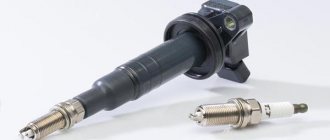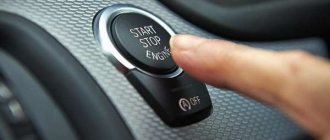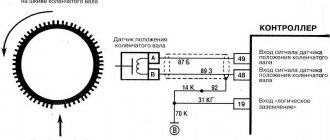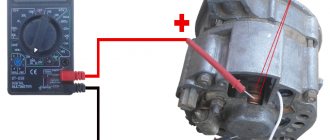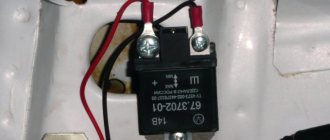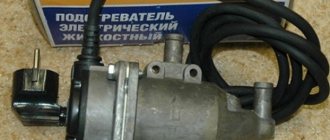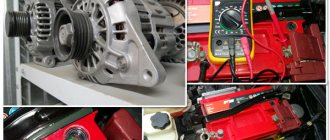The glow plug relay is one of the most important parts of a diesel engine, without which it is unlikely to be able to start it, for example, in cold weather. This relatively small part, which today works in tandem with the ECU, is rather an assistant in normal engine starting, but it cannot be discounted. Let's figure out how a car glow plug relay works, how to diagnose its failure and how to select it if necessary. We will also touch on issues related to replacing this relay itself.
Signs of faulty glow plugs
Indirect signs of the presence of a malfunction:
- When starting, white-gray smoke comes . This indicates that fuel is flowing but is not igniting.
- Rough operation of a cold engine at idle . The noisy and harsh operation of the engine can be noticed by the shaking plastic parts of the interior due to the fact that the mixture in one cylinder ignites late due to the lack of heating.
- Difficulty starting a diesel engine when cold . You have to do several repetitions of spinning the engine with the starter.
Clear signs of a bad glow plug will be:
- Partial destruction of the tip .
- A thick layer of carbon deposits on the tip near the body.
- Swelling of the glow tube (occurs due to excess voltage).
How can you check the glow plugs of a diesel engine?
How to check?
Depending on the model and age of the car, there are different principles of operation of the diesel engine heating system:
- In older cars, glow plugs usually turn on almost every time the engine is started.
- Modern cars can start successfully even without glow plugs at above-zero temperatures.
Therefore, before starting to diagnose the diesel preheating system, you need to find out at what temperature conditions the combustion chamber is heated. And also, what type of candle, since they are divided into two groups: rod (the heating element is made of a refractory metal spiral) and ceramic (the heater is ceramic powder).
Environmental standards Euro 5 and Euro 6 provide for the operation of diesel engines with ceramic spark plugs, since they have the function of pre-starting and after starting heating, which allows the fuel to be burned in a cold engine, as well as an intermediate glow mode necessary to ensure regeneration of the particulate filter.
To check the spark plugs of a Ford, Volkswagen, Mercedes or other car diesel engine, you can use several methods , and depending on whether they are unscrewed or on the engine, the principle will be the same. Functionality testing can be done using:
3 ways to check glow plugs - video
- Battery _ On the speed and quality of incandescence;
- Tester . By checking the break of the heating winding or its resistance;
- Light bulbs (12V). The simplest test for breakage of the heating element;
- Sparking (can only be used in old diesel engines, since new ones are dangerous due to ECU failure);
- Visual inspection.
The simplest diagnosis of glow plugs is to check their electrical conductivity. The spiral must conduct current, its resistance in a cold state is in the range of 0.6–4.0 Ohm . If you have access to the candles, you can “ring” them yourself: not every household tester is able to measure such a low resistance, but any device will show the presence of a heater break (the resistance is infinity).
If you have a non-contact (induction) ammeter, you can do without removing the spark plug from the engine. But it is often necessary to inspect the working part, on which signs of overheating may be noticeable - melting, deformation of the tip, up to its destruction.
In some cases, in particular if all spark plugs fail at once, it may be necessary to check the vehicle's electrical equipment. Namely, the spark plug control relay and its circuits.
We will describe all the ways to check diesel glow plugs. The choice of each of them depends on skills, availability of equipment, tools and free time. But ideally, you need to apply everything together, plus a visual inspection.
This is interesting: How many liters of oil are in a VAZ 2105 engine
How does it all work?
Ignition of the fuel-air mixture in the cylinders of a diesel engine occurs at temperatures of 800–850 °C. When the engine is warmed up, such indicators, at the moment of the compression stroke, are achieved instantly and the diesel engine starts without failure.
But when the car is not warmed up, it is difficult to achieve such a temperature only by compressing the mixture, especially in cold weather - starting the engine is problematic.
To solve this problem, glow plugs were installed in diesel engines, the task of which is to very quickly warm up the air in the cylinders to 75 degrees and thereby ensure the desired temperature at the moment of the compression stroke.
Inside the products, two spirals are structurally provided - heating and regulating.
The first one has a heating function. The second, due to floating electrical resistance, protects the glow plug from overheating.
The spark plugs will work until the coolant temperature goes above 60°C, this is about 3 minutes. Then the motor will be able to work without them.
Before starting the car, you must turn on the ignition and pay attention to the instrument panel. A glowing spiral indicator indicates that the glow plugs are heating up. As soon as the light goes out, you can start the car.
In modern cars, the spiral lamp may not light up. This will happen if the engine is already warmed up, which means there is no need for glow plugs. All this is achieved thanks to modern electronics that monitor the temperature indicators of the motor.
There are also glow plugs that maintain the temperature for a long time after warming up, and therefore turn off immediately after the starter is turned off and heat the air in the diesel cylinders due to residual heat.
The devices are very energy-consuming; heating one glow plug to 850-1350°C in half a minute can take an average of 8-16A (96-192 W), sometimes 40A. The amount of voltage and the time it is supplied are controlled by an electronic unit and a thermal relay (switch).
The latter, if necessary, only closes and opens the circuit, thereby setting the desired air temperature in the cylinders. And the ECU regulates the entire heating process by sending signals to the relay. It takes the necessary information from the crankshaft and coolant sensors.
The first sign indicating that one of the glow plugs has failed will be the re-ignition of the indicator in the form of a spiral after starting the engine and its prolonged burning (about 50 seconds).
If after the specified time, after warming up the car, the indicator does not go off, then the time relay (thermal switch) has failed. It is important to immediately replace the device, otherwise the glow plugs will fail due to the burnout of their heat pin.
If it is still relatively warm outside (above +5°C), then you are unlikely to notice the output of one or two products; the car will still start.
Otherwise, when the thermometer scale approaches zero and below, even with one faulty spark plug, starting the car when cold is problematic. This can only be done if it is heated to 60°C or more.
see also
Comments 25
did you take the glow plug relay from an Audi of the 80s? It has 7 contacts, if you want the diagram I’ll send it to you in PM
I don’t understand why the candle is a torch. Are we talking about those glow plugs that are installed in each cylinder?
No, there’s one spark plug here, in front of the turbine.
Then I don't know. My Toyota diesel did not have a turbine))
I had an Estima diesel car with a 3speed engine. So that’s where the candles are glowing. The operating principle is as follows. When starting, the spark plugs burn for about 5 seconds. Then they go out. And when cranking the start, they light up again and stay on for 5 to a minute. It depends on how many are overboard. And they don't burn. I see I’ve already figured out the connection. Pay attention to the voltage at the spark plugs. Maybe it’s below 12. Then that’s why it burned. And if it’s not a secret, then why do you need it?
So I have a candle on Ivek, so I’m dealing with it.
Maybe the relay is stuck. I don't know the circuit diagram on your model. So it burned out
Sorry, the question is not clear, if this is a torch plug, then where is the fuel control valve, the torch heating turns on after -20 or even -25, or is it a glow plug just heating
Is this a question from a physics test at school?
By circuits, and knowledge of the contact numbers on the relay. Well, you can also make non-crossing wires in the diagram. Not any auto electrician will undertake such work. Although maybe a guy somewhere is trying to break the captcha. BGGGGGGGGgggggggggggggggggggg.
Like any other load, probably.
There are different types of candles! at 10 volts at 11 or 11.5 maybe there are other voltages. As I understand it in a diesel engine, it works through a special relay that gives heat for a certain time before starting to warm up the combustion chamber. They burn out because it must work for at least 20 seconds. and a maximum of 40 seconds. before starting the engine. Place the lamp directly parallel to the spark plug, but you will have to look for the relay! At a minimum, the way out is to simply power up the button via the relay and press it for 30 seconds before starting. I repeat - spark plugs are only needed for starting! Then they turn off! since they consume a lot of current, first the spark plugs turn on, then they turn off, and only then turn on the starter!
A lamp in the form of a spiral, or a regular 12V control?
and which one is better to put?
I just don’t know where it is, and what kind of spark plugs it is, on tractors, for example, the lamp was a spiral, and was switched on in series with the spark plugs, which provided both heating control and resistance for the spiral
and which one is better to put?
Yes, you can put an LED on it to indicate that there is power to the candle. Place it parallel to the candle and that’s it. Good luck!
look in the bulletin board, I installed an additional relay on the starter there, I think you can do the same)
What is it for
It's no secret that today the most common internal combustion engines run either gasoline or diesel. Gas-cylinder installations are gradually gaining popularity, but since they are not the topic of our discussion, we will leave them for later. So, the main executive component of the car ignition system is presented today:
- Glow plug in diesel engines;
- The spark plug, respectively, in gasoline engines.
The principle of operation of a spark plug can only be described as “the formation of a spark at a strictly defined point in time.” The spark plugs of diesel engines are not so strictly tied to time - the fuel, when compressed, begins to ignite spontaneously. However, another problem arises: spontaneous combustion does not always occur when it is needed. This is where glow plugs are needed. They heat the fuel mixture to the optimal temperature for engine operation and make its further combustion process stable and predictable. However, another problem appeared!
As a diesel engine operates, its individual components become very hot. Increasing temperatures also have a detrimental effect on the fuel. There are often cases when it begins to burn even before it gets into the cylinder, where the heat of combustion will be used to perform work. The weak link is the glow plugs - if they heat up too much, they destabilize the operation of the entire engine. To solve this problem, engineers introduced special relays.
A relay is an electrical device that can close or open a circuit in the event of a change in some controlled quantity . With the glow plug relay, everything is very simple: when the glow plug needs to work, it allows the action of current, but when the spark plug needs to “cool down,” the relay opens the circuit. This chain will be looped until the driver turns off the engine.
What is important to know
A car engine works in tandem with a large number of elements. Undoubtedly, one of the most important is the electronic control unit. It is he who calculates the time that the candles should work. The ECU is guided by readings from the temperature sensor. The relay, in fact, is located between the ECU and the glow plugs themselves, so as soon as one element malfunctions or fails altogether, the entire chain collapses. But here, too, not everything is so simple. Let's figure it out.
Modern diesel cars use what is called two-stage heating of the pre-chambers . Of course, it is gradually being replaced by a single-stage one, but since the system is still relevant, it would be useful to know why spark plugs may not work properly. Look here:
- At the 1st stage, the spark plugs receive power from a voltage source of about 11-12 Volts . When the spark plugs warm up, this voltage drops to 9 Volts. The first stage is before starting the engine. When the engine can be started, the warning light on the instrument panel goes out. You can move to the second stage;
- Already at the 2nd stage, the voltage decreases noticeably: 5-7 Volts . The temperature of the spark plugs, of course, is lower - now they only maintain the stability of the engine before it reaches the optimal temperature.
Spare parts for Volkswagen golf
Glow plug relay
GOLF III hatchback (1H1) (08.91 - 07.98)
Spare parts for Audi 80
Glow plug relay
80 sedan (89, 89Q, 8A, B3) (06.86 - 10.91)
We considered it necessary to note all this for one simple reason: if the ECU malfunctions or if the standard relay has been replaced with an unsuitable one, normal operation of the spark plugs is simply impossible. If the relay does not work, then the spark plug does not work either - during periods of severe cold, this puts an end to any attempt to start the engine.
We will continue to study the system so that the car enthusiast in the future will clearly know what the problems in the fuel heating system are associated with. Between the relay and the glow plug there is a current-limiting resistor - the most common resistor that prevents the plug from failing under the influence of overcurrents. The resistor is also connected to the motor control unit (it would be more correct to say that with a separate current sensor on this unit), and based on its serviceability, the unit judges whether the glow plugs are still working. When replacing glow plugs, inexperienced or inattentive repairmen forget to connect the wire from the current-limiting resistor to the ECU. For this reason, the entire glow plug system fails.
Brand tour
When choosing a glow plug relay, it makes sense to be guided not only by data on compatibility with the car, but also by who manufactured it. Today on the market you can find both budget analogues and first-class parts that are in no way inferior to the originals. We advise you to take the latter - they last a long time and work well, unlike the cheap “China” ones. And here's who produces the best relay:
- Beru (Germany);
- Vemo/Vaico (Germany);
- Jideco (Japan);
- Bosch (Germany);
- NGK (Japan).
Of course, there are budget solutions, and even two: used relays or relays from a low price category. Cheap does not always mean bad, but a cheap device always fails before a more expensive and high-quality one. To save on the purchase of a glow plug relay, you can buy spare parts from the following companies:
- Huco (Germany);
- ERA (Italy);
- Trucktec (Germany);
- Cargo (Denmark);
- Meyle (Germany).
Even if you find a cheap relay from a non-name manufacturer in the store, it is not worth buying. Often you have to wait weeks for delivery of such devices, but the wait in this case is justified - by taking a budget device, you are actually signing up to change the relay next winter.
Reasons for failure
There are two main reasons for glow plug failure:
- Failure of fuel equipment components, for example, a faulty thermal relay;
- Maximum service life of the spiral.
Approximately, every 75-100 thousand (often after 50-75) km, you need to diagnose the spark plugs and, if necessary, change them. As a rule, not only the faulty product is replaced, but all products at once.
The service life of glow plugs can be reduced by:
- Dirty or faulty injectors - a fuel jet directed at the heating element destroys its body, and subsequently the coil itself.
- Incorrect installation of products;
- Glow plugs sticking to the cylinder head - in this situation, they often break during dismantling.
- A faulty thermal relay will lead to overheating of the heating elements, their spirals will burn out, and the housings will become deformed;
- Faulty ECU.
This is interesting: What kind of oil should I put in a viburnum box?
Test methods (diagnostics)
Many diesel car owners will say that the weak link in their car is the glow plugs. And this is not far from the truth.
These products really often fail, and the breakdown could have occurred in the summer, but it would appear in the winter, when the car stopped starting in cold weather.
Before diagnosing a malfunction, it is important to understand the principle by which diesel heating works in your car.
At the moment there are two of them:
- Turning on the glow plugs every time you start the engine is typical for older diesel engines.
- Periodic activation of heating elements depending on the temperature of the engine and the air supplied to the system.
It is also important to understand what types of glow plugs are installed, rod or ceramic.
If your car meets environmental standards up to Euro 4, then most likely the diesel engine has rod heating elements. If Euro 5, 6 - ceramic.
The latter have many additional features, the main ones:
- Intermediate glow function, with which the DPF particulate filter is regenerated.
- Pre- and post-start heating – ensures that the fuel burns out in a cold engine.
To check glow plugs, for example, on Renault Megane 2 station wagon 1.5 86 hp, Ford Mondeo 2 1.8 90 hp, Ford Transit 2.2, Renault Laguna 3 or other cars with diesel engines, you can use several methods. Moreover, the approach to checking will be the same regardless of whether they are removed from the engine or standing still.
Verification methods:
- BY VISUAL INSPECTION. The integrity and condition of the relay and wiring are checked, and after removal, the product itself is checked;
- USING A TESTER (MULTIMETER). The winding resistance or its breakage is checked.
- SPARKING. It is not used on new diesel engines with an ECU, since the latter may fail.
- USING A 12V BULB. A simple way to check for a broken spiral.
For quick diagnostics, provided you have access to the glow plugs and a multimeter, you can measure their resistance. You need to check it when it is cold. The advantage is the presence of a non-contact ammeter (induction type). Indicators should vary from 0.6 to 4.0 Ohms. A new spark plug may have 0.7-1.8 ohms.
If your tester does not show such a low resistance, then you can check for a break in the spiral - readings to infinity (1) will indicate this.
Also, many multimeters support the sound signal function when the wiring is ringing - there is a sound, which means the spiral is intact.
Despite the results obtained, an external inspection of the spark plugs is recommended, especially if the car’s mileage has exceeded 50 thousand km. The presence of tip deformation, melting, and soot deposits are unacceptable.
If the results of preliminary diagnostics are disastrous for all glow plugs at once, then most likely, a complete diagnostic of the electrical equipment included in the heating system will be required, since the simultaneous failure of all products indicates a global malfunction.
To check glow plugs on a diesel engine, in addition to visual inspection, you must use all the methods described below.
Each of them will require the presence of certain instruments and knowledge in electrics, but if you repair electrical wiring yourself at home at a household level, you will figure it out here too.
Checking with a tester
To check you need a multimeter . If a car enthusiast doesn’t already have one, then the device is definitely worth buying - it will be useful not only for diagnosing faults in the car’s electrical components, but will be useful in everyday life. A standard Chinese multimeter is quite inexpensive, and a separate article can be written about its usefulness. To check the glow plug relay with a conventional multimeter, you need to do the following:
- Set the measuring device to voltmeter mode ;
- Connect the multimeter probes, or better yet alligator clips, with the plus to the glow plug bus, and the minus to the engine ground;
- Turn the car's ignition key to its first position;
- Listen and check the multimeter readings. The relay operates with a characteristic click, which is clearly audible in the absence of extraneous noise (it is best to work in a garage). The display should show readings: from 8 to 12 Volts . On engines with a two-stage heating system, 4-5 seconds after the first click, a second click will be heard, and the voltage shown by the measuring device will decrease by almost half.
If everything is in order, then the problem does not necessarily lie in the glow plugs. You can begin further checks. And this is what they provide:
- Checking the integrity of the wires . It would be more correct to say that all wiring needs to be ringed. We are interested in the wires leading to the relay;
- Checking the terminals . Often they are covered with a layer of oxide - they need to be cleaned;
- Checking the fuse . Firstly, if the fuse is blown, there will be no voltage supplied to the spark plugs. Secondly, a light will light up on the dashboard.
And now we come to the main thing. If the glow plugs, all the wiring with terminals, and the fuse are in order, it is logical to assume that problems with the diesel heating system are related to the spark plug relay. Finding a relay is not difficult: it is always larger than other relays and has more power. The sequence of actions when checking relays from different manufacturers may also be different, but here are general recommendations:
- As soon as 12 volts , the control contacts close;
- If you connect a light bulb to the control contacts, then when voltage is applied to the coil contacts, this light bulb should light up;
- If the relay does not operate ( no click is heard ), it is faulty. The coil in a faulty relay burns out - repairmen do not undertake to change just one coil, so all relays will have to be replaced with a working one;
- The coil windings must have resistance, which will be shown by checking with an ohmmeter. If the device shows a break, then the relay coil has burned out;
- In two-stage glow systems, the relay has more than 4 contacts , so before starting the test it is worth studying the car manual. However, there is a general rule: always check the circuits for breaks.
In general, there is no particular difficulty in checking. A full check will take a lot of time, since it is advisable to check not only the relay, but also all the elements that are located between it and the glow plugs. It’s worth starting with the glow plugs - they fail more often than any other element of the heating system.
Sometimes the solution to the problem is unexpected: try removing the relay, pulling it out of the case, sending it back, and then putting the entire device back in place. As owners of Volkswagen diesel cars say, dismantling and subsequent installation of the relay helped solve the problem with “sticking” - sometimes the contact remains in one position and the relay cannot close the circuit, but with a slight mechanical impact everything returns to normal.
Relay operating principle
The principle of operation of the glow plug relay is to control the voltage supplied to the glow plugs and the ability to regulate it. The device also controls the heating duration and temperature. The performance of the part directly depends on the readings of the crankshaft speed sensors and coolant temperature.
Modern diesel devices are designed in such a way that heating is carried out not only before starting, but also after the engine starts running. This allows you to reduce noise when the engine is running and significantly reduce harmful emissions into the atmosphere.
How does ignition occur in a diesel engine?
Conclusion
Finding and selecting a suitable glow plug relay is not particularly difficult. The operating principle and design of these parts are the same, so there will be no problems with finding interchangeable relays and the necessary chips ( exception : if you install a relay from an old car to a newer one and vice versa). Moreover, due to the high survivability of relays from well-known German companies, you can even buy used ones. Glow plug relays that were already in use can easily be found at auto wrecking yards. If a car enthusiast’s budget is very limited, he can always find budget solutions. It is worth checking relays and glow plugs before every winter, so that problems with these parts do not take the car enthusiast by surprise.
Checking the battery
This method involves removing all the glow plugs. This is labor-intensive work and takes some time, part of which is to open access to the products themselves.
But this is the most informative method, guaranteeing a good result, since each candle is in front of your eyes and the entire heating process is clearly visible. You can immediately visually identify obvious defects.
To check, you will need a charged battery and a wire up to 1 meter long, but not less than 50 cm.
The peculiarity is that you can check each spark plug separately or connect everything in parallel (the same current will flow to all elements).
The latter method will be preferable, since it will allow you to immediately visually assess the heating rate of all rods, which should be the same (the difference is no more than 1 s), but it will also require more wires and preparation time.
Check procedure:
- A wire is attached to the “-” terminal of the battery;
- The center of the glow plug is pressed against the “+” terminal;
- We press the negative wire to the body of the product.
The rod should heat up quickly (on average 2-5 seconds) starting from the tip and have a cherry tint. If there is no heating or it is slow, then the spark plug is faulty.
It is advisable to measure the heating time of the tip of each candle from the start of heating until it acquires a cherry hue in order to compare later.
Glow plugs with the same heating time should be divided into groups. The group that enters the average warm-up time of 2-5 seconds remains, the rest are replaced.
Proper warming up.
Not correct.
The ideal option would be when you have a new glow plug and its performance can be taken as a reference.
POPULAR WITH READERS: Causes of smoke from the exhaust pipe, gasoline and diesel engines
As for heating elements that heat up very slowly, the situation here is clear, but many will have a question - “why throw away candles that heat up too quickly?”
Warming up too quickly indicates that the products are not fully heated, but only partially, i.e. The efficiency of their work is minimal, which means they do not perform their functions. As a rule, such glow plugs exhibit mechanical damage to the housing.
WHY IS THIS SO IMPORTANT? Let's imagine a situation where the air in the cylinders is heated at different time intervals and poorly (the spark plug operates with low efficiency).
It turns out that in one cylinder everything is fine, the mixture ignites on time, in the other, on the contrary, the mixture ignites late. Vibration in the cabin and engine jerking will indicate this problem.
Replacing an element
When the test shows that the device is not functioning, it needs to be replaced. Even a less experienced car enthusiast can do this. To do this, you will have to disconnect all the terminals from the part and take it out. Then it is important to clean the place where the device was removed. Then you need to carefully unscrew all the spark plugs. Next, carry out the entire process in reverse order, only with a new block: screw the glow parts into the new block, install it in a previously cleaned place.
The location of the candles is shown by red arrows
After this, you should try to start the engine. If this does not work, then you need to check whether all terminals are connected. If everything is installed correctly, but the engine still does not start, then the problem was probably not in the glow elements.
It is important to note that different vehicles may require different types and models of glow elements.
Owners of cars running on diesel fuel should prepare in advance for the cold season and check the functionality of the relay. It is also worth keeping control over the candles themselves. It is especially important to check the performance before a long journey. Otherwise, the trip may be disrupted and postponed until the problem is resolved.
Changing the filling of the glow plug relay
Replacing a relay is a fairly simple process and can be done by absolutely anyone, even those who have looked under the hood of a car for the first time. It is necessary to disconnect the relay, as was done in the test description, that is, disconnect all the terminals and carefully remove the relay out. Then it is advisable to clean the place where it was installed, as well as the part itself, which you have already successfully removed. After you have finished wiping, slowly unscrew the spark plugs from the relay. It is best if you work with special gloves.
Then, with a rag, we remove excess dust in the holes where the glow elements were installed, and begin to smoothly screw in the new spark plugs already purchased for your car. This fact needs to be noted: each car has different types and models.
You should consult your dealer when purchasing these parts. After you have screwed in the spark plugs, install the relay in place and try to start the engine. If your car does not want to start, check that you have connected all the terminals. If your car does not start even after checking, then most likely the problem was not with the spark plugs.
«>

